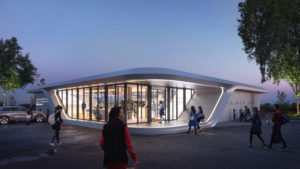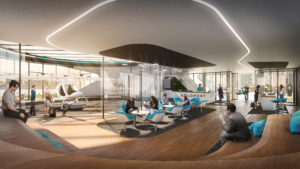What Exactly is a Volo-Port? Skyports and Volocopter Announce First Air Taxi Port Will Be Built by the End of 2019
Urban air mobility (UAM) is more than just a cool idea. At drone conferences around the world, UAM is a hot topic as both regulators and communities seek for a way to address an increasingly significant urban problem: traffic. For many cities around the world, adding transportation infrastructure on the ground is simply not an option – highways don’t have room for another lane. There is, literally, no where to go but up.
Enter the concept of a multimodal urban transportation infrastructure that includes air taxis. “Multimodal transportation infrastructure” is the concept of using multiple transportation methods for any trip – for example, many commuters now take a combination of longer range rail transportation and shorter range bus or subway: UAM imagines a short drone taxi ride as part of the trip which might cut traffic, pollution, and travel time.
Many such solutions have been envisioned. Uber has presented its version: there is a drone taxi service currently operating – albeit on a very limited demonstration basis, rather than as an integral part of the urban transportation system – in Dubai. But UK-based “vertiport” company Skyports, partnered with air taxi producers Volocopter, have announced that they will be first with a completed air taxi Volt-Port – a landing pad for an electric vertical take off and landing (eVTOL) air vehicle.
All images featured in this article are provided by courtesy Volocopter and Skyports, and are protected by copyright.
The following is taken from a Skyports and Volocopter press release.
Greentech Festival, Berlin – Today, Skyports and Volocopter announced a cooperation to build the first mobile Volo-Port for air taxis. UK-based global vertiport owner and operator Skyports and air taxi pioneer Volocopter unveiled plans for the Volo-Port – the physical landing pads for so-called eVTOL (electric take-off and landing) – through stunning designs produced by internationally renowned agency Brandlab.
Ground-based vertiport infrastructure is critical to the success of future urban air mobility (UAM), including air taxi operations in congested cities. Construction of the first Volo-Port will be completed later this year. The partners plan to build it in Singapore for the scheduled public flight trials in the second half of 2019. A full-scale Volocopter vehicle is on display at the GreenTech Festival.
The Volo-Port prototype will:
- Enable real-life testing of the full customer journey to perfect the passenger experience;
- Showcase planned customer services, including pre-flight checks, passenger lounges and boarding procedures;
- Allow practical testing of ground operations and services, including battery swaps and charging, maintenance, safety and security;
- Provide the opportunity for authorities and industry regulators to interact with the infrastructure and provide feedback before they are asked to approve the final design.
Vertiports are the only physical infrastructure required for air taxis to commence operations in cities in the near future. Volo-Ports are designed to provide passengers with a seamless air taxi experience that is safe, secure, and relaxing. They will merge with their surroundings, allowing passengers and passers-by to see through the whole structure.
Brandlab together with Graft Architects and Arup won the Volocopter international tender to produce the Volo-Port design.
“Receiving the commercial license for air taxi aircraft is a question of time not possibility. We are thus focusing on shaping the necessary ecosystem around UAM including air traffic management, city regulation and the take-off and landing infrastructure. It takes visionary partners like Skyports and Brandlabs willing to make investments to actively shape the future of urban air mobility.”, says Alex Zosel, Co-Founder of Volocopter. “Once regulation comes through on the aviation and city level – and this will be sooner than most think – we will be ready to take off.”
“Each individual Volo-Port is designed so that it can stand alone or connect to other ports in numerous formations, enabling rapid deployment and scalability. We have analysed the available spaces and movement dynamics in city centres across the world and recognize that infrastructure is a key enabler for the emerging UAM market. We are delighted to be building the world’s first operational Volo-Port in partnership with Volocopter.” says Duncan Walker, Managing Director of Skyports.
“Mobility patterns in cities worldwide are changing rapidly – seamless transitions from one mode to another are crucial for transport efficiencies and changing passenger demands. Our design of the architecture, as well as all services along the whole customer journey, link ground to air infrastructure in the smoothest way possible. Passengers experience the connection to the sky through our design. We aim to build trust and create excitement.” says Linda Stannieder, Co-Founder and CEO of Brandlab.
Miriam McNabb is the Editor-in-Chief of DRONELIFE and CEO of JobForDrones, a professional drone services marketplace, and a fascinated observer of the emerging drone industry and the regulatory environment for drones. Miriam has a degree from the University of Chicago and over 20 years of experience in high tech sales and marketing for new technologies.
Email Miriam
TWITTER:@spaldingbarker
Subscribe to DroneLife here.
####post_link##



